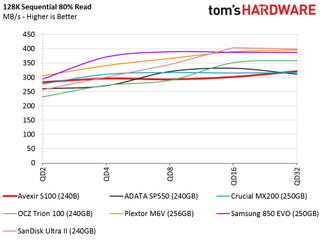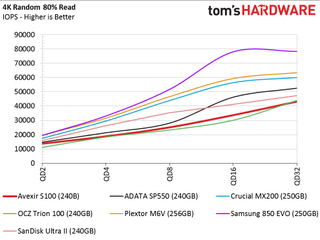Avexir S100 LED SSD Review
Avexir's attempt to crowdfund the S100 only netted $2,100 out of the $50K goal, but the company was still able to bring the drive to market. We finally have the first LED SSD with a fighter jet theme in for testing.
Why you can trust Tom's Hardware
Benchmarks And Comparisons
Comparison Products
It's been quite a long time since we've tested a single 256GB-class SSD on its own. This capacity is falling out of favor with many users now that the prices of 512GB SSDs have come down. Entry-level 256GB SSDs now start as low as $50 and scale up to just over $100.
Samsung's 850 EVO is not as dominant at this capacity as it is in larger capacities, but it is still the standard by which we measure all other entry-level and mainstream SSDs.
To read about our storage tests in-depth, please check out How We Test HDDs And SSDs. Four-corner testing is covered on page six of our How We Test guide.
Sequential Read Performance


The Avexir S100 240GB SSD with asynchronous MLC flash trails the pool of entry-level products. TLC flash dominates this category, but the Crucial MX200 and Plextor M6V use MLC NAND. With so many TLC products on the list, we expected the S100 to land somewhere in the middle of our sequential read chart. That didn't happen. The drive had a difficult time scaling with the increasing queue depth and peaked just a little over 500 MB/s.
Sequential Write Performance



You might expect consistent sequential write performance with the Avexir's MLC flash, but that wasn't always the case. The JMicron 670H controller employs an SLC write buffer on the MLC flash to hide low write performance. We measured a 440 MB/s sequential write burst, but the performance quickly dropped to 300 MB/s during one of our extended tests. The S100's performance is still faster than the native TLC sequential write speeds found with many other products with a similar capacity, but not by much.
The HD Tune Pro test reveals severe performance degradation after we write just a few gigabytes of data to the drive. This performance degradation is crushing for users that operate with a lot of data on the drive, and it shows that performance will slow after installing a game or application. The drive appears to use very aggressive garbage collection, and later in this review, we will show how it actually helps long-term performance when the drive has time to recover.
Random Read Performance



The Avexir S100 240GB ranks among the bottom of the group of entry-level SSDs during the random read performance tests. The S100's low queue depth performance is not too bad, it ranks in the middle of the group, but it suffers from poor performance at high queue depths. This tendency will have a negative impact on power users running many simultaneous applications during heavy multitasking workloads.
Random Write Performance



The MLC flash allows the S100 to rank in the middle of the random write performance charts. The S100's performance is far from amazing. It's important to remember that the test pool only examines other low-cost products, and it omits high-performance SSDs, such as the SanDisk Extreme Pro and Samsung 850 Pro.
80 Percent Sequential Mixed Workload
Our mixed workload testing is described in detail here, and our steady state tests are described here.

We've tested the JMicron 670H extensively over the last year. The controller has poor mixed workload performance regardless of the product, the design or the company releasing it. The S100 and the OCZ Trion 100 dragged the bottom of the chart during the mixed sequential test.
80 Percent Random Mixed Workload

Random mixed workload performance was just as bad. The S100 manages to outperform the OCZ Trion 100 at some queue depths, but we don't consider that a meaningful victory.
Sequential Steady State



The S100's asynchronous MLC flash acts more like TLC when it is in steady state. The JMF670H controller is the likely source of the problem. In our sequential steady-state test, the performance hovers around 80 MB/s until we get to a 100 percent read environment. We wouldn't recommend running this SSD with a lot of data on the drive.
Random Write Steady State


From the test results alone, it's difficult to even imagine that the S100 even uses MLC. Here we write 4KB data to the drive until it is full, then we pepper the entire span of the addressable capacity with random writes while the SSD is in a steady state condition. The S100 falls to zero IOPS in many places, and even some of the TLC NAND-based SSDs outperform it. We can't recommend this product for use in a RAID array because performance consistency has a huge impact on the user experience.
Current page: Benchmarks And Comparisons
Prev Page Specifications And Features Next Page Performance And ConclusionStay on the Cutting Edge
Join the experts who read Tom's Hardware for the inside track on enthusiast PC tech news — and have for over 25 years. We'll send breaking news and in-depth reviews of CPUs, GPUs, AI, maker hardware and more straight to your inbox.
-
g-unit1111 This would look amazing in an NZXT H440 / S340 or any case where they show off the SSDs. But in a case that hides the SSDs I kind of fail to see the point of a drive with RGB lighting.Reply -
Glock24 Why on earth does this exist? It has non-standard height, low performance for it' s price and probably low endurance. Also, who need LEDs on a SSD? I know aesthethics are subjective, but it looks like something I'll give to my 3-year old.Reply -
Gam3r01 There's a reason it only earned 2,100 bucks out of 50k.Reply
Still entertaining how a company asks for consumer money to make a product, dosent get any, and still brings it to market huh? -
Brian_R170 Hopefully, the crowdfunding support isn't an indication of how much Avexir overestimated the market size for this product.Reply -
mll0576 Uhhh how can you review a LED ssd without pictures of it's ONLY feature that makes it stand out??? DUUHHHHReply -
mll0576 Reply18501074 said:Uhhh how can you review a LED ssd without pictures of it's ONLY feature that makes it stand out??? DUUHHHH
18501186 said:The first picture on the front page shows it lit up.
Then the photographer should be fired - u can hardly see it. -
Virtual_Singularity "If you are shopping for this SSD, you are likely more concerned with the look of the drive than its performance."Reply
Precisely. Sums it up right there.
"Hopefully, the crowdfunding support isn't an indication of how much Avexir overestimated the market size for this product."
Maybe not. But one can hope.



